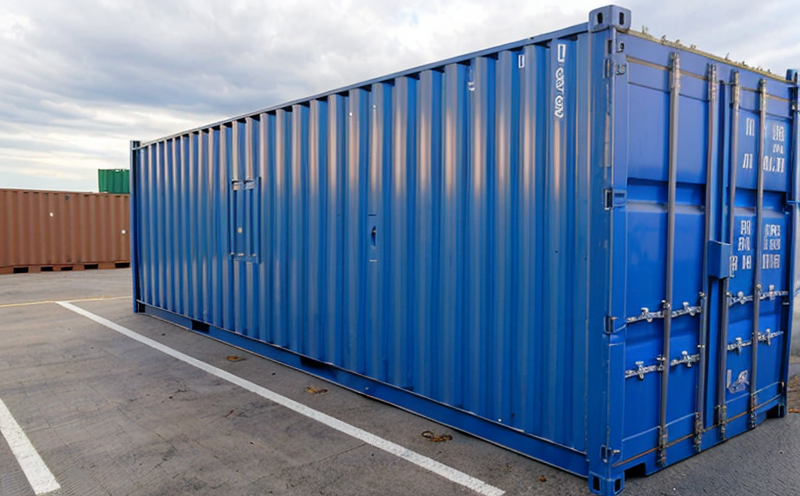ASTM D1709 Dart Impact Testing of Plastic Storage Containers
The ASTM D1709 standard provides a standardized method to determine the impact resistance of plastic containers, particularly those used for storage. This test is essential in quality assurance programs that aim to ensure the durability and safety of plastic containers across various industries such as food packaging, pharmaceuticals, and consumer goods.
The ASTM D1709 test involves subjecting a container to an impact using a dart-shaped projectile dropped from a known height onto the top surface of the sample. The standard specifies the dimensions and shape of the dart, the method for determining the height at which it strikes the specimen, and the criteria for evaluating the results.
The primary purpose of this test is to simulate real-world conditions where plastic containers might encounter sudden impacts, such as during shipping or handling. By quantifying the impact resistance, manufacturers can optimize their designs to meet both performance requirements and safety standards.
Before conducting the test, it is crucial to ensure that the specimen meets certain specifications outlined in ASTM D1709. This includes specifying the container's material, dimensions, and any additional factors like thickness or shape that might affect impact resistance. The testing apparatus used should also be calibrated according to the standard to guarantee accurate results.
The test procedure involves placing the plastic container on a rigid surface with its open end facing downward. A dart-shaped projectile is then dropped from a height of 18 inches (457 mm) onto the top surface of the container. The impact force is measured, and the result is recorded based on whether or not the container sustains damage.
The results are typically reported as either pass/fail criteria or as a measure of energy absorbed by the container during the test. A pass indicates that the container did not sustain any visible damage after being impacted with the dart from the specified height. Conversely, a fail would indicate that the container showed signs of damage.
ASTM D1709 is widely used across various sectors including packaging, consumer goods, and pharmaceuticals. By ensuring compliance with this standard, manufacturers can demonstrate their products' durability and safety, thereby gaining competitive advantages in the market.
Scope and Methodology
| Parameter | Description |
|---|---|
| Test Specimen | Plastic containers with open ends, typically used for storage. |
| Dart Shape and Dimensions | A dart-shaped projectile with specific dimensions as per ASTM D1709. |
| Impact Height | 18 inches (457 mm) from the top surface of the container. |
| Test Environment | Standard laboratory conditions to ensure consistent results. |
| Evaluation Criteria | Vizual inspection for visible damage or failure in the container. |
The test procedure strictly follows ASTM D1709. The specimen is prepared according to standard specifications, and the apparatus used must be calibrated correctly to ensure accurate results. The dart-shaped projectile is dropped from a fixed height onto the top surface of the container, and the impact force is recorded.
After each test run, the container is visually inspected for any signs of damage or failure. If no visible damage is observed, the container passes the test; otherwise, it fails. The results are then reported based on these criteria to ensure compliance with ASTM D1709 standards.
Industry Applications
- Packaging of food and beverages
- Storage solutions for pharmaceuticals
- Retail goods packaging
- Hazardous material transport containers
The ASTM D1709 Dart Impact Testing is particularly useful in industries where the integrity of plastic storage containers is critical. For instance, in food and beverage packaging, ensuring that containers can withstand accidental drops or impacts during transportation ensures product safety and consumer trust.
In pharmaceuticals, compliance with this standard helps guarantee that the integrity of medication containers remains intact under various conditions, thus protecting patient safety. Retail goods packaging also benefits from this test to ensure durable storage solutions for a wide range of products.
Hazardous material transport containers are another critical application where ASTM D1709 is used to assess their structural integrity and resistance to impact. This ensures that these containers can safely transport potentially dangerous materials without risk of leakage or damage.
Why Choose This Test
The ASTM D1709 Dart Impact Testing is a vital tool for ensuring the durability and safety of plastic storage containers. By simulating real-world impact scenarios, this test helps manufacturers identify potential weaknesses in their designs early on. This allows for necessary modifications to be made before products reach the market.
Furthermore, compliance with ASTM D1709 standards enhances a company's reputation by demonstrating its commitment to quality and safety. Many regulatory bodies require adherence to such standards, making ASTM D1709 testing not only beneficial but also mandatory in some cases.
The test also provides valuable insights into the impact resistance of various materials used in container production. This information can be crucial for product development teams looking to innovate or improve existing products. By understanding how different materials perform under impact stress, companies can make more informed decisions about material selection and design optimization.
In summary, choosing ASTM D1709 Dart Impact Testing ensures that plastic storage containers meet the highest standards of quality and safety, thereby protecting both consumers and the environment from potential hazards associated with container failure.





